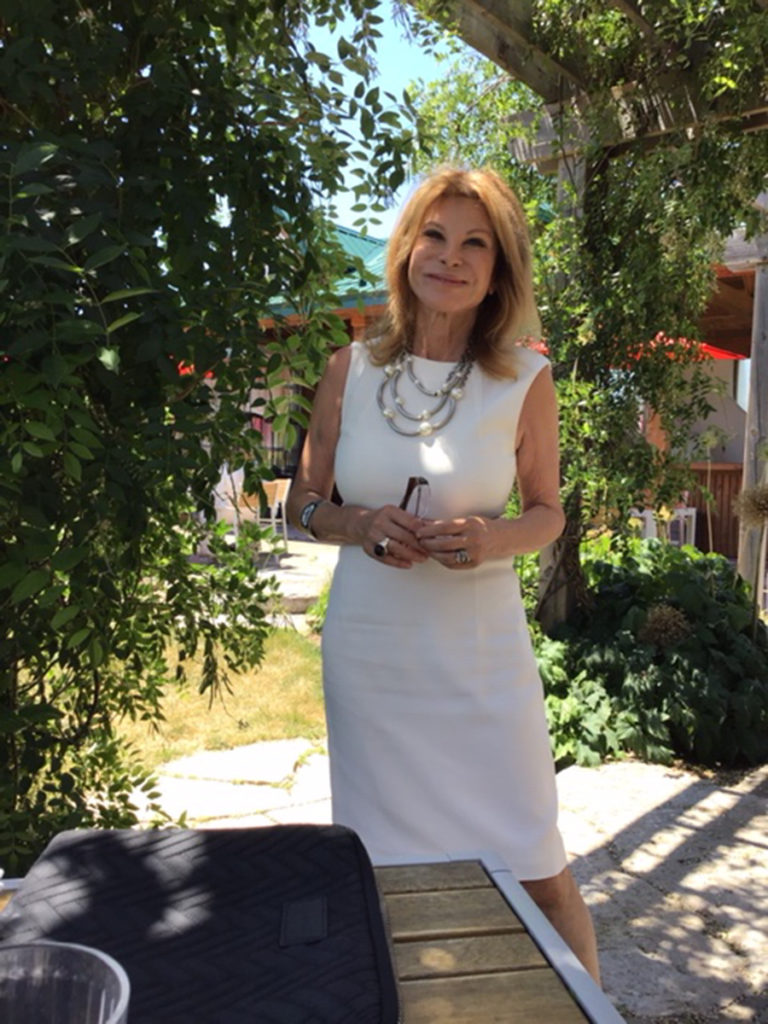Dr. Gelareh Zadeh is a surgeon-scientist who excels in the research lab and the OR.
By Diane Peters
On Christmas Day 2016, Chrissie Rejman’s dizziness got so bad that she was stumbling around the house. Her son – whom she affectionately calls Mr. Worrywart – declared he’d had enough of this six-month-old worsening health issue and called an ambulance.
An emergency room doctor told Rejman, who’s now 71, that he suspected she had an acoustic neuroma, which is a non-cancerous brain tumour that grows in the vestibular nerve in the inner ear, causing dizziness and also hearing loss. Indeed, hearing tests soon confirmed, to her surprise, that she’d lost a quarter of her hearing in her left ear. “You don’t really realize when you’re going deaf,” says Rejman.
Luckily, in early 2017, Rejman got a formal diagnosis and top-notch care from one of the best doctors in the country, Dr. Gelareh Zadeh, Head of the Division of Neurosurgery and the Division of Surgical Oncology in the Sprott Department of Surgery, the Wilkins Family Chair in Neurosurgical Brain Tumour Research, and the Medical Director of the Krembil Brain Institute. “She was terrific,” recalls Rejman of Dr. Zadeh.
Indeed, Dr. Zadeh is known as a rock star in neurosurgery. She specializes in some of the most complex neurosurgeries – removing skull-base tumours, of which acoustic neuromas are one – runs a busy and successful research lab, and still finds time to take leadership roles, including those at top international neurological medical organizations.
Innovations in surgery
At Sprott Surgery, Dr. Zadeh is part of a powerhouse team of neurosurgeon-researchers who are both treating patients, and researching new treatments and approaches to surgery. She and her colleagues are developing innovative ways to treat brain tumours, including using lasers and less invasive procedures to help patients like Rejman avoid brain surgery. While the rise of technology in brain surgery could, in theory, limit her work in the future, “nothing can replace talking to the patients and sitting with them to hear their stories,” says Dr. Zadeh.
Her research focuses on skull-base tumours, meningiomas in particular, but she’s also researching ways to treat other cancers, such as glioblastoma, the most common type of adult brain cancer.
Despite her high-level expertise – Dr. Zadeh has a PhD in molecular biology and did a fellowship in radiobiology – she clearly cares about her patients. “She’s very approachable and very calm, and you can talk to her – you can ask her anything. Not a lot of doctors are like that,” says Rejman.
When Dr. Zadeh met with Rejman, she saw that surgery wasn’t the best option for her growing tumour. Instead, she suggested Rejman try gamma knife radiation, a non-invasive procedure that targets a tumour with hundreds of highly accurate and powerful radiation beams. Rejman had the procedure in early 2019 and it has, so far, stopped the growth of the tumour.
Marathon operations
Most of Dr. Zadeh’s time is spent in the operating room. While she performs a wide range of brain surgeries – on the day we spoke to her, she had to rush off to operate on an emergency room patient with a blocked brain shunt – she’s an expert in tumours that are located near the base of the skull, such as acoustic neuromas.
Most skull-base tumours are benign, and the larger ones that cannot be treated by a non-invasive procedure like gamma knife radiation require careful surgical removal. Surgery is done using a microscope and can take five to 12 hours, as the surgeon has to carefully distinguish between the tumour and the surrounding tissue, which are often the same colour. It doesn’t help that these tumours grow in an area of the body that contains tiny, sensitive nerves that control things like blinking and the movement of the lips.
Dr. Zadeh thrives on these marathon operations. She does about 10 skull-base surgeries a month, along with an average of 10 more brain procedures. “When we use the microscope, we have to remain focused for the entire duration of the operation,” she explains. “It’s very rewarding work, because with surgery you can cure the majority of the skull-base tumours.”

Radiation to the rescue. Chrissie Rejman, who was helped by gamma knife radiation, can smile knowing her neurosurgeon is one of the best in the country.
Researching cures
When she’s not being a surgeon-scientist, she’s a volunteer, working for organizations like the Acoustic Neuroma Association of Canada, where she’s Medical Director, and at the Society for Neuro-Oncology, where she’s President, the first woman to ever hold that prestigious position.
With 25 Canadians being diagnosed with brain tumours every day, the medical community needs leaders and innovators like Dr. Zadeh, who pushes the field forward with new treatments but also cares for her patients. Some, like Rejman, live with the effects of their brain tumours for life, which means doctor and patient will be interacting for years. “It’s a long-term relationship,” notes Dr. Zadeh.
While Rejman’s tumour is no longer growing, it’s still there. She’s lost the hearing in her left ear and has to manage her dizziness on a daily basis, but she knows she’s got one of the top neurosurgeons in the country monitoring her condition, offering her support and staying on top of treatment innovations. Says Rejman of Dr. Zadeh, “She’s an expert in everything.”
Minds matter, tumours impact everyone.
120+ The number of different types of brain tumours (Source: Brain Tumour Foundation of Canada)
55,000 Canadians living with a brain tumour (Source: Brain Tumour Foundation of Canada)
This article originally appeared in the 2020 Sprott Department of Surgery magazine.
